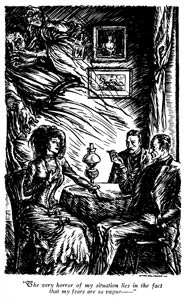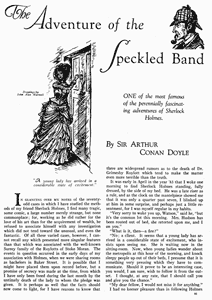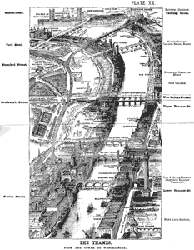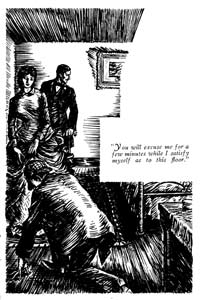Issue 2 : The Adventure of the Speckled Band
First published in The
Strand Magazine February, 1892.
…the well-known Surrey family of the Roylotts
of Stoke Moran.
The county of Surrey is located south and southwest of London. The town
of Leatherhead, mentioned later by Miss Stoner, is a bit more than 20
miles from Baker Street. There is no town called Stoke Moran, but there
is a Stoke D'Abernon a few miles from Leatherhead.
It is perhaps as well that the facts should now come to light, for
I have reasons to know that there are widespread rumours as to the death
of Dr. Grimesby Roylott which tend to make the matter even more terrible
than the truth.
Not only did Conan Doyle possess a great talent for creating intriguing
plots, he knew how to tempt the reader into the story with hints of the
horrors to come.
"Very sorry to knock you up, Watson," said he, "but it's the common
lot this morning. Mrs. Hudson has been knocked up, she retorted upon me,
and I on you."
Holmes means that Mrs. Hudson woke him up, and now he is waking Watson.
John Alan Maxwell
illustrated the 1930 reprint of "The Speckled Band" in the
American magazine The Golden Book. |
Conan Doyle has Watson insert a bit of background for those intermittent readers of The Strand Magazine who might not have read a Holmes story before.
"I am glad to see that Mrs. Hudson has had the good sense to light the fire. Pray draw up to it, and I shall order you a cup of hot coffee, for I observe that you are shivering."
True to his character, Holmes observes the young woman's shivering, but fails to divine its emotional cause.
"…a good drive in a dog-cart…."
A dog-cart is a generic term for a rustic, one-horse cart meant to convey one or two people.
"…and came in by the first train to Waterloo."
Waterloo Station serves the south and southwest rail corridor from London. Miss Stoner must have taken a cab across the Thames for about four miles to reach Baker Street from Waterloo."
"…and the estates extended over the borders into Berkshire in the north, and Hampshire in the west."
That is, the estate was so large it extended into two neighboring counties.
"…in the days of the Regency."
Between 1811 and 1820, the future King George IV ruled as Regent for his father, George III, who suffered from periodic insanity.
"…and went out to Calcutta…."
The capital of Britain's Indian colony.
Waterloo Station, or
the London & Southwestern Railway Terminus, is at the top left of the map |
 |
Illustration from the
American reprint |
The self-justifying mythology surrounding British colonial rule of India centered on the terrible "trials" the British suffered for the sake of "civilizing" the Indian people. Chief among these "trials" was the tropical climate (with its attendant diseases, like malaria), which was considered to be bad for the British "constitution," and sometimes to be the cause of madness.
"He had no friends at all save the wandering gipsies, and he would give these vagabonds leave to encamp upon the few acres of bramble-covered land which represent the family estate, and would accept in return the hospitality of their tents, wandering away with them sometimes for weeks on end."
The "gipsies" (gypsies), or Roma, as they prefer to be called today, are a nomadic people from northern India who migrated west to Europe in the 14th century. In Conan Doyle's time, their true origins were unknown, but there were many theories. Their dark skin, itinerant lives, and different customs made them convenient scapegoats for problems without an obvious cause: thefts, well-poisoning, livestock deaths, etc. The fact that Dr. Roylott lives with the gypsies would make him suspect in the eyes of many of Conan Doyle's readers.
"He has a passion also for Indian animals, which are sent over to him by a correspondent, and he has at this moment a cheetah and a baboon…."
While cheetahs do exist in India, baboons are found only in Africa.
"…who lives near Harrow…."
Harrow is a northwest borough of London, bordering on Hertfordshire.
"…and met there a half-pay major of marines…."
In other words, the major was no longer on active duty when Julia met him.
"…and though he poured brandy down her throat…."
In Victorian times, brandy was considered a restorative medicine.
"His name is Armitage—Percy Armitage—the second son of Mr. Armitage, of Crane Water, near Reading."
Reading is a city in the county of Berkshire, also known as Royal Berkshire, in the Thames Valley, about 20 miles due west of central London. Crane Water is a picturesque name for an imaginary town.
"When you combine the ideas of whistles at night, the presence of a band of gipsies who are on intimate terms with this old doctor, the fact that we have every reason to believe that the doctor has an interest in preventing his stepdaughter's marriage, the dying allusion to a band, and, finally, the fact that Miss Helen Stoner heard a metallic clang, which might have been caused by one of those metal bars that secured the shutters falling back into its place, I think that there is good ground to think that the mystery may be cleared along those lines."
"But what, then, did the gipsies do?"
"I cannot imagine."
"I see many objections to any such theory."
"And so do I. It is precisely for that reason that we are going to Stoke Moran this day. I want to see whether the objections are fatal, or if they may be explained away."
Here we see a good illustration of Holmes's methodical working practice. Refusing to theorize ahead of facts, he formulates a logical theory that might explain one of the few facts he has—the metallic clang, which could have been caused by the bar holding the shutters slamming down. Beyond that, he does not try to guess what the gypsies might or might not have done. Holmes's gradual progress towards the truth by trial and error adds to the suspense and heightens the reader's interest.
His costume was a peculiar mixture of the professional and of the agricultural, having a black top hat, a long frock coat, and a pair of high gaiters, with a hunting crop swinging in his hand.
The top hat and frock coat are suitable for town, while the gaiters (high spats buttoned over the shoe and lower part of the trouser leg to protect them from mud) and the riding crop suggest the country.
"Holmes, the Scotland-Yard Jack-in-office!"
A "Jack-in-office" is a self-important and rude minor bureaucrat. Dr. Roylott is accusing Holmes of being an insignificant appendage of the London Police.
"…and afterwards I shall walk down to Doctors' Commons, where I hope to get some data which may help us in this matter."
Located near St. Paul's Cathedral, Doctor's Commons was the old hall where wills, marriage licenses, divorces, other civil records were stored. By 1883, when this story takes place, all records had been transferred to Somerset House on The Strand.
"An Eley’s No. 2 is an excellent argument with gentlemen who can twist steel pokers into knots."
It is uncertain what kind of revolver Holmes is asking Watson to carry, since the Eley Brothers manufactured ammunition, not guns.
…a narrow white-counterpaned bed….
A bed with a white bedspread.
…a square of Wilton carpet in the centre.
Wilton carpet is a short-weave carpet with a sheared pile that gives it a velvet texture, as opposed to Brussels carpet, which is unsheared. In Holmes’s times, Brussels was considered everyday carpet, used in private areas of the house, while the more expensive Wilton carpet was a luxury that might only appear in rooms where guests were received. Perhaps Julia and Helen Stoner, being deprived in most areas, allowed themselves a little extravagance.
Holmes examines the floor
with his magnifying glass. Note the deerstalker hat, not mentioned
in the story, but by 1930 a firmly established bit of Holmesian lore. |
Holmes must test his theory before he reveals it, thus keeping both Helen Stoner and the reader in suspense.
"Palmer and Pritchard were among the heads of their profession."
William Palmer and Edward William Pritchard were two 19th-century doctors convicted of poisoning family members. Holmes’s statement that they were "among the heads of their profession" must be ironic, since the only profession either excelled at was murder.
"It is a swamp adder!" cried Holmes—"the deadliest snake in India. He has died within ten seconds of being bitten."
Sherlockians have argued long and hard about what species of snake might have bitten Dr. Roylott. The color, description, and behavior of this snake fit no known reptile, and no venomous snake can kill its victim in ten seconds.
"Violence does, in truth, recoil upon the violent, and the schemer falls into the pit which he digs for another."
Holmes rarely quotes Scripture, although he often comments on the justice or injustice of a criminal’s fate. Here, he expresses sentiments that recur several times in the King James Bible. Ecclesiastes (10:8): "He that diggeth a pit shall fall into it; and whoso breaketh an hedge, a serpent shall bite him," and Proverbs (26:27), "Whoso diggeth a pit shall fall therein: and he that rolleth a stone, it will return upon him."


